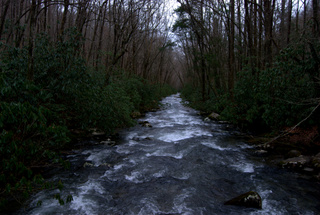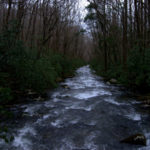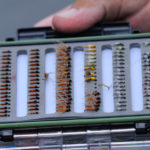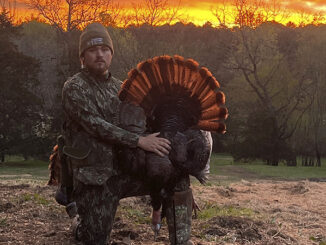
Know when, where to fish different styles
Fishers have been fooling trout into taking artificial flies since the days of ancient Macedonia — and probably much longer — and that practice has changed very little in the intervening years.
Fly fishers utilize five types of flies, each designed to imitate a particular phase of an insect’s life, a particular insect or a particular kind of aquatic life. Basic types of flies are dry, wet, nymph, streamer and terrestrial.
Dry-fly fishing is the most-exciting type of fishing, because it is more visual than other methods. You can see a trout rise to an insect, and you can see a trout rise to an artificial dry fly. Hook a rising trout on a dry fly, and if that doesn’t get your adrenalin pumping, take up bowling.
A dry fly is constructed so that it settles delicately and naturally on the surface of a stream and floats into the view of an unsuspecting trout. Basic components of a dry fly are hackle, wing, body and tail.
Hackle, made from the long, slender feathers of a cock, gives the fly its floating qualities. Hackle is wound in a full circle around the hook just behind the eye. The stiffness of hackle feathers allows the fly to sit on the surface. In addition to helping the fly float, hackle also simulates the wings, legs and tail of an insect. Dubbing, usually made of animal fur and secured with thread, forms the fly’s body. Various other materials such as tinsel, floss, and peacock herl are designed to give the fly a realistic appearance.
Common dry-fly patterns used in mountain streams are Adams (male and female), Blue-Winged Olive, Royal Wulff, Caddis, Yellow Sally, Stimulator, Palmer, Thunder Head, Quill Gordon, Hendrickson, Cahill and Stone.
A wet fly looks very much like a dry fly, but it doesn’t float on the surface. It imitates a drowned surface insect, an emerging nymph or an adult female that goes beneath the surface to lay its eggs. The basic components of a wet fly are about the same as a dry fly, except that it is usually tied with soft hen hackle instead of stiff cock hackle to make it more absorbent. A wet fly generally imitates the emerging stage of an insect, and it is fished beneath the surface and given occasional tugs to simulate a swimming insect. Most wet flies are tied with the feathers and hairs lying along the shank of the hook so that the fly will slide easily through the water. Wet flies often are used as droppers off dry flies.
Common wet fly patterns are Coachman, March Brown, Gold-Ribbed Hare’s Ear, and Zulu and soft-hackle patterns. Most dry-fly patterns can be tied wet by using softer hackle.
Neither wet flies nor dry flies have to be exact imitations of an insect, merely a reasonable approximation. Looking up to the surface, a trout gets a distorted view of a floating dry fly. A wet fly usually is fished in fast water, and a hungry trout doesn’t have time to scrutinize it.
Nymphs, however, have to be close duplications of the real thing since they represent the larval stage of an insect when the insect has very little swimming power. Nymphs tumble along the bottom or lie on the bottom. Since there is little distortion beneath the surface, a trout has plenty of time to examine the fly. If the fly doesn’t look like the real thing, the trout is going elsewhere to eat. In still water, nymphs make up about 90 percent of a trout’s diet, and they are available food year-round.
Nymphs are cast upstream, above feeding trout, and allowed to tumble naturally down to the trout. In dry-fly fishing, the fly always is visible, but in nymph fishing, you see neither the fly nor the trout taking the fly. Nymph fishing requires time and patience to master because you have to learn to detect a strike, which sometimes can be as subtle as a slight pause in the drift of the leader.
Common nymph patterns are Copper John, Girdlebug, San Juan Worm. Stick Bait, Tellico, Secret Weapon, Pheasant Tail, Prince and Zug Bug.
Streamers, also called bucktails, are the flies fishers use when they want to catch big browns and rainbows. Streamers imitate swimming aquatic life such as minnows, dace and sculpin. They are usually stripped through the water to simulate the darting, swimming patterns of small fish. Streamers come in large patterns, anywhere from a No. 10 to a No. 4.
Common streamers are Muddler Minnow, Woolly Bugger, Kiwi Zonker, Sculpzilla, Mini-Loop Sculpin, Black Nose Dace, Shiner and Threadfin Shad.
Terrestrials imitate various crawling, flying or hopping insects such as Japanese beetles, grasshoppers, ants, inchworms and crickets. These flies can be fished either beneath the surface or on the surface. Terrestrials can be used from early summer to first frost.
Size is an important, although not critical, factor in fly fishing. The fly should be close to the size of the insect or aquatic life it is imitating as possible. Hooks for trout flies range in size from 0 to 32. The higher the number, the smaller the hook. Most American flies are measured in even sizes. Common sizes for dry flies used in mountain streams are 12 to 18. Flies that imitate small insects such as gnats and midges usually are 20 to 24. Small flies such as these require excellent eyesight or a magnifying glass.
Veteran fly fishers carry an assortment of flies in various sizes. If one type of fly or size doesn’t work, try another pattern in a smaller or larger size. If you’re persistent, you’ll eventually discover the right combination.







Be the first to comment